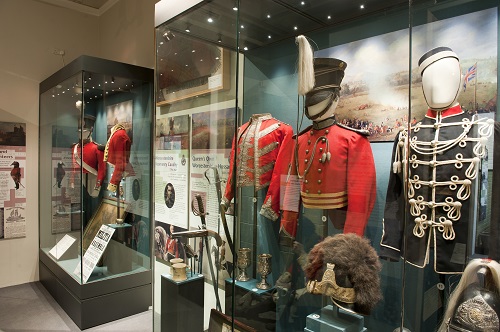The collections of the Mercian Regiment Museum Worcestershire are currently housed in display galleries at the Art Gallery and Museum, called “The Worcestershire Soldier”, with the help of a grant from the Heritage Lottery Fund. The Worcestershire Soldier exhibition tells the story of the men of our county Regiments from 1694 to the present. These soldiers lived and sometimes died in the defence of the country and its interests overseas. Using archive film, memories and the unique collections of The Mercian Regiment Museum (Worcestershire) and Worcestershire Yeomanry, this display brings over 300 years of military history to life.
- Marvel at the achievements of the men and their journeys overseas.
- Try on uniforms and discover how heavy soldiers’ equipment was to carry.
- Listen to soldiers’ tales of battle and bravery.
- Discover the regimental traces that can be seen around Worcester City today
- Begin your research into the history of families linked with the regiments.
- Find out about the wives and children left to guard the Worcester Home Front during World War 2.
Drawing on these collections, and objects from the Worcestershire Yeomanry Cavalry and the Worcester City collections, the displays tell the story of the people of Worcestershire and their role in the defence of Britain for over 300 years.
The Regiment’s collections are presented using archive, photographic and oral history records to illustrate the lives of individual soldiers and their families.
The Museum of the Worcestershire Yeomanry is housed within the City Art Gallery and Museum. The collections are the property of the Worcestershire Yeomanry Museum Trust, which maintains close links with the successor regiment, the Royal Mercian and Lancastrian Yeomanry, but are managed by Worcester City Museums. Objects in the collections tell the story of the regiment over the last 300 years.

Worcester City Art Gallery and Museum
Uniforms
From its foundation in 1794 the Yeomanry had distinctive items of uniform. Examples of 19th century headgear include a Tarleton helmet, busbies, shakoes, which make colourful displays together with coatees, tunics and their epaulettes and braiding. Uniforms from the Boer War and the First World War can be seen alongside a Tank Overall worn in France in the Second World War.
Arms
19th century swords and pistols include the fine pair of duelling pistols given to the Adjutant, Captain Emmot by the Earl of Plymouth in 1832. There are also more recent firearms, as well as spurs, saddlecloths and sabretaches reflecting the cavalry aspect of this regiment.
Guidons
These eleven beautifully embroidered pieces, including the King’s Guidon presented in 1831, have recently been conserved.
Emblems and Medals
These include examples of the sprig of pear blossom in silk which was presented to the troops on their departure to the Boer War by the Countess of Dudley, and of the silver medallions known as Worcestershire Jewels presented on their return.
Paintings
Watercolours by Richard Dighton showing caricatures of the Officers between 1832 and 1834 contrast with those painted by Lord Hampton whilst serving in Palestine in the First World War.
Photographs
A wide range of official and personal photographs from the Boer War to recent times include poignant images of the charge at Huj in 1917 in Palestine.
Personalia
A wide range of material including letters, diaries and souvenirs. The ploughshares created from a Turkish and an English sword used at Huj by an Officer who became a clergyman are evocative. Maps and cooking equipment illustrate life in the Second World War.
If you would like to see the Regimental Gallery, it can be found in Worcester City Art Gallery and Museum.

